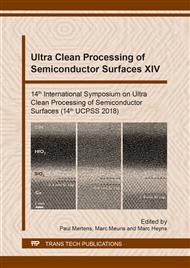[1]
L. Broussous, O. Hinsinger, S. Favier, P. Besson, Post-Etch Cleaning Chemistries Evaluation for Low k – Copper Integration, Solid State Phenom. 92 (2003) pp.263-266.
DOI: 10.4028/www.scientific.net/ssp.92.263
Google Scholar
[2]
L. Broussous, W. Puyrenier, D. Rebiscoul, V. Rouessac, A. Ayral, Porous low-k wet etch in HF-based solutions : focus on cleaning process window, pore sealing and k recovery,, Solid State Phenom. 145-146 (2009) pp.295-302.
DOI: 10.4028/www.scientific.net/ssp.145-146.295
Google Scholar
[3]
B. Peethala, F.W. Mont, S. Molis, R. Knarr, B. L'lherron, C. Labelle, D. Canaperi, S. Siddiqui, Impact of HF-based cleaning solutions on via resistance for sub-10nm BEOL structures,, Microelectron. Eng. 161 (2016) pp.98-103.
DOI: 10.1016/j.mee.2016.04.005
Google Scholar
[4]
D. Rébiscoul, L. Broussous, D. Louis, G. Passemard, Study of the kinetics of the copper cleaning by X-ray reflectometry" in "Cleaning Technology in Semicondutor Device Manufacturing IX, Ed. J.Ruzyllo ECS trans, v1 n°3, (2005) pp.365-372.
Google Scholar
[5]
S. Bilouk, L. Broussous, R P. Nogueira, V. Ivanova and C. Pernel, Electrochemical Behavior of Copper and Cobalt in Post- Etch Cleaning Solutions,, Microelectron. Eng.v86 (2009) p.2038–(2044).
DOI: 10.1016/j.mee.2009.01.035
Google Scholar
[6]
D. Shamiryan, M.R. Baklanov, G. Vereecke, S. Vanhaelemeersch and K. Maex, Modification of low-k SiCOH film porosity by a HF solution,. Solid State Phenom. Vols. 76-77 (2001) pp.135-138.
DOI: 10.4028/www.scientific.net/ssp.76-77.135
Google Scholar
[7]
T. Oszinda, M. Schaller, D. Fischer, C. Walsh, and S. E. Schulz, Investigation of physical and chemical property changes of ultra low-κ SiOCH in aspect of cleaning and chemical repair processes,. Microelectron. Eng. 87(3), (2010) p.457–461.
DOI: 10.1016/j.mee.2009.06.028
Google Scholar
[8]
N. Posseme, T. David, P. Meininger, O. Louveau, T. Chevolleau, O. Joubert, D. Louis, Impact of downstream ash plasmas on ultra low-k materials,, Solid State Phenom. 103–104 (2005) 337–340.
DOI: 10.4028/www.scientific.net/ssp.103-104.337
Google Scholar
[9]
V. McGahay, Porous Dielectrics in Microelectronic Wiring Applications,, Materials (2010), 3, 536-562.
DOI: 10.3390/ma3010536
Google Scholar
[10]
Q.T. Le, et al., Removal of Plasma-Modified Low-k Layer Using Dilute HF: Influence of Concentration., Electrochemical and Solid-State Letters, 8(7) (2005) p.F21.
DOI: 10.1149/1.1928234
Google Scholar
[11]
W. Puyrenier, V. Rouessac, L. Broussous, D. Rebiscoul, A. Ayral, Characterization of the impact of plasma treatments and wet cleaning on a porous low k material,, Microelectron. Eng. v83, n°11-12, (2006), pp.2314-18.
DOI: 10.1016/j.mee.2006.10.024
Google Scholar
[12]
L. Broussous, W. Puyrenier, D. Rebiscoul, V. Rouessac, A. Ayral, Porosity and structure evolution of a SiOCH low k material during post-etch cleaning process,. Microelectron. Eng. (2007), 84, 2600–2605.
DOI: 10.1016/j.mee.2007.07.001
Google Scholar
[13]
E. Ramanathan, M.C. Sylvestre et al., effect of top corner rounding in BEOL to yield in advanced technologies,. Proceedings of ASMC 2015 (2015) p.68.
DOI: 10.1109/asmc.2015.7164453
Google Scholar


